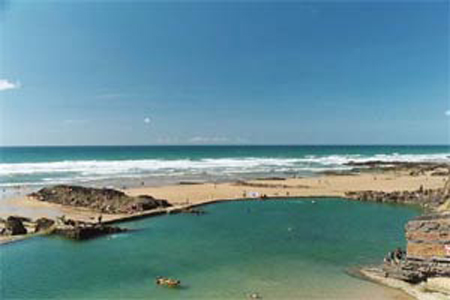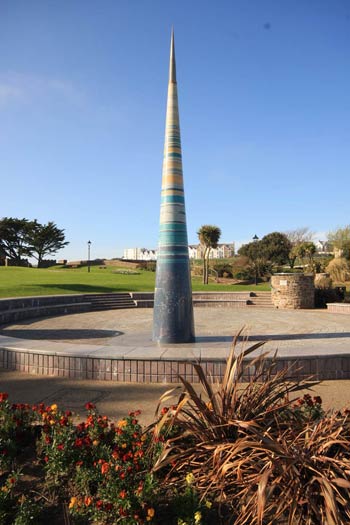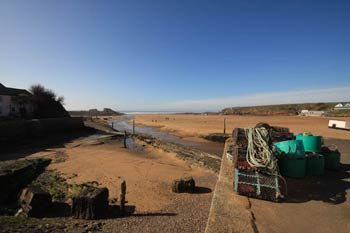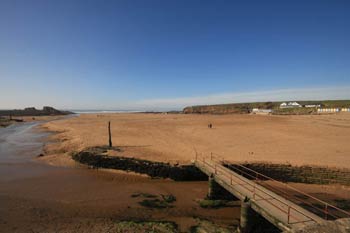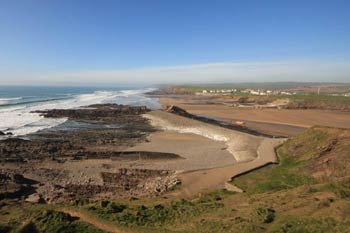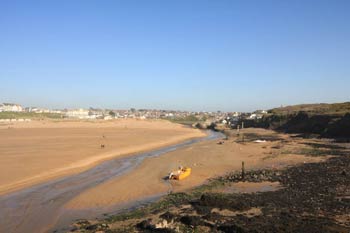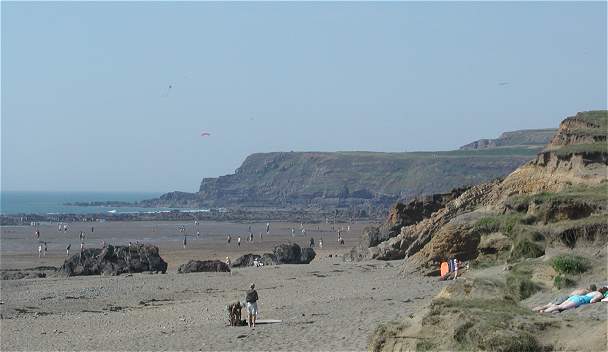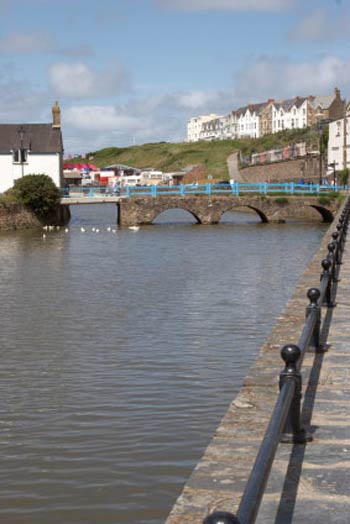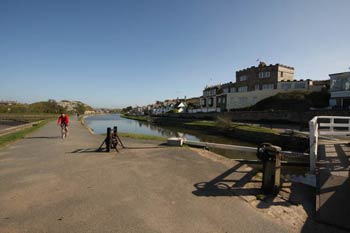|
Bude in North Cornwall - Holidays in Bude Tourism Guide |
|||||||||
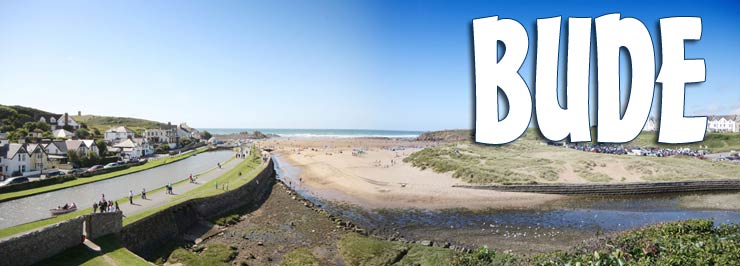 |
|||||||||
Padstow | Wadebridge
| The Camel Estuary | Rock
| Polzeath | Port
Isaac | Trebarwith Strand
|Tintagel | Bossiney
Cove | Rocky Valley
| Boscastle | Crackington
Haven | Bude | Clovelly
| Launceston | Camelford
| Altarnum | Bodmin
|
|||||||||
BUDEThe popularity of Bude as a seaside resort dates from Victorian timesBude has managed to retain its atmosphere of easy going charm whilst catering for the most discerning of modern day tourists.The town overlooks a wide bay of hard golden sand flanked by spectacular cliffs and protected by a breakwater. There is a seawater swimming pool under Summerleaze Downs which means safety for swimmers even at low tide. Bude's Sea pool is approximately 290 feet long by 140 feet wide with a walkway around the edge. Two excellent lifeguard patrolled beaches - Crooklets and Summerleaze - have extensive flat sands when the tide is out and are perfect for beach lovers of all ages. As well as the seawater pool, Bude now also boasts a large heated indoor leisure pool with flume, wave machine and cafe. Laser dome, trampolines, putting, floodlit tennis courts, mini-golf and go-karting close to the beaches all add to the family fun. In the 19th Century it was notorious for its wreckers, who plundered the ships that came to grief off the coast - more than 80 between 1824 and 1874. In 1823 the Bude Canal was constructed to carry beach sand - used as a fertiliser - 20 miles inland to Launceston and for exporting Local produce. It was this waterway that brought development to the town. The canal is now used for pleasure-boating and fishing. The Castle, a castellated stone mansion standing on a grassy knoll overlooking Summerleaze Beach, was built in 1830 by the inventor Sir Goldsworthy Gurney, the first man to make a long journey in a mechanical vehicle - a steam carriage - from London to Bath and back. The building now houses the Town Council's offices: with the delightful grounds used for band concerts and fetes held throughout the summer help.
The town itself offers a wide range of amenities for the holiday maker and a visit to the splendid new Visitor Centre in the Crescent car park would be an excellent placed to start. Alongside an extensive display by the North Cornwall Heritage Coast and Countryside Service, and a children's area, a full range of tourist information is available and the staff will be pleased to help you plan your holiday - whatever the weather. Bude offers Summer theatrical shows, concerts, regular dances, discos, numerous fetes and events, many with an historical theme, specially staged for visitors. Attractions include a weekly Cornish Furry Dance, full scale Carnival Week, Folk and of course the internationally renowned 8 day Jazz Festival. In fact something for everyone!
|
|||||||||
|
|
|||||||||
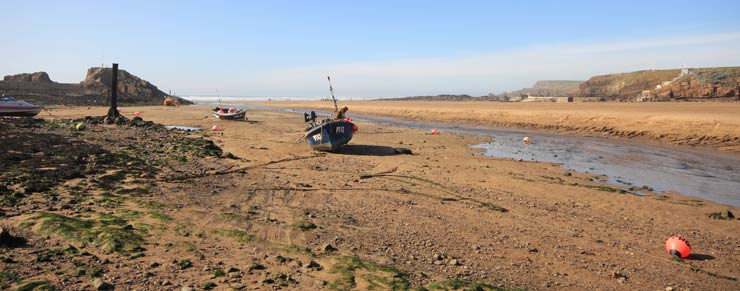 |
|||||||||
Several years ago the phrase "the liveliest peace of Cornwall" was coined to describe the pleasure of Bude and its environment, and despite the fact that it has now become the centre for several Festivals, little has changed to alter this claim. The natural beauty of the surrounding countryside and rugged coastline have been carefully preserved. Crisp, clean sands, great Atlantic surfing rollers, a high rate of sunshine and walks with magnificent views of Bude Bay, are there for the visitors' enjoyment and always will be. The choice is yours: whether to soak up the excitement and atmosphere of one of the Festivals, or to just soak up the peace and sheer beauty of the environment, whether to participate in the many and varied activities or to relax totally in a town renowned for its helpful friendliness. One word of warning though - we have it on good authority that one visit to Bude is rarely enough - many visitors return again and again to experience this "the loveliest peace of Cornwall". STRATTON, the parent town of Bude, probably dates back to Roman times, but it was as the stronghold of King Charles and the Royalists that it made its mark in history. During the Civil War the 7'4" Cornish giant, Anthony Payne, was enlisted as a bodyguard to the Royalist Sir Bevil Grenville. He fought beside Sir Bevil, Who commanded the King's army in the victorious battle at nearby Stamford Hill in 1643. Payne lived and died in the Grenville manor house at Stratton - now the Tree Inn. It is said that, when the giant died, the house had to be restructured to allow his huge coffin to be carried in and out. Many of the very fine churches of Cornwall still bear the Royal Crest decreed by the King in gratitude to his loyal Cornishmen during the Civil War. South West Water has completed the first "Clean Sweep" programme in Bude to guarantee clean bathing water on Bude's beaches. Water quality testing takes place on a regular basis and results are consistently amongst the best in the country. Please note there are restrictions on taking dogs on certain beaches from April to October. Ask at Bude Visitor Centre for full details. CROOKLETS AND SUMMERLEAZE are the two fine Bude beaches, of which mention has been made before. It is possible, at low tide, to walk to Summerleaze from Sandymouth, Northcott Mouth or Crooklets - please check on the tide times and make sure you won't be trapped against the cliffs by the incoming tide. Summerleaze Beach is a picturesque sandy beach located in the seaside town of Bude, North Cornwall, England. It is known for its stunning coastal views, clean waters, and family-friendly atmosphere. The beach is adjacent to a natural sea pool, which is a popular spot for swimmers of all ages, especially at low tide. The pool is a safe haven for bathing and offers a more sheltered alternative to the open sea. The area is well-managed with lifeguards on duty during the peak season, ensuring safety for visitors. Facilities include a beach café, toilets, and showers. There is also a large car park nearby, making it easily accessible for those planning a day trip. Summerleaze Beach is a great place for a variety of activities such as surfing, bodyboarding, and kayaking due to its consistent waves. It is also ideal for sunbathing, beach games, and building sandcastles. The beach is dog-friendly all year round, with designated areas for dogs to run and play. Bude is a charming town with a variety of shops, restaurants, and accommodation options, making it a convenient base for exploring the surrounding Cornish countryside. The beach is backed by grassy dunes and a promenade, which leads to the town's amenities, including the Bude Canal, perfect for a leisurely walk or cycle. The beach is well-managed for environmental conservation, with regular clean-ups and efforts to maintain the natural habitat of the area. It holds a Blue Flag award for its high standards of water quality, safety, and environmental management. Summerleaze Beach is a beautiful and well-facilitated destination, providing a mix of recreational and relaxation opportunities, making it a favorite among locals and tourists alike. Crocklets Beach is a picturesque and popular sandy beach located in the coastal town of Bude, North Cornwall, England. Known for its stunning coastal views and excellent water quality, it is a favorite destination for surfers, sunbathers, and families. The beach is situated just a short walk from the town center and is adjacent to the Bude Sea Pool, an open-air, tidal swimming pool carved into the rocks, which adds to its charm and appeal. The beach is relatively small, but it offers a great variety of activities and facilities. It is well-managed and maintained, with lifeguards present during the peak season to ensure the safety of visitors. Crocklets Beach is excellent for swimming and surfing due to the consistent waves and relatively safe conditions, particularly for beginners. However, it can get quite busy, especially during the summer months, so it is advisable to arrive early to secure a good spot. Facilities at Crocklets Beach include public toilets, showers, a beach café, and nearby parking. Dogs are allowed on the beach all year round but must be kept on a lead between Easter and October. The beach is also part of the South West Coast Path, making it a great starting point for coastal walks along the dramatic cliffs and rugged landscape of the area. In terms of nearby attractions, the town of Bude offers a range of shops, restaurants, and accommodation options, as well as the Bude Canal for those interested in watersports or leisurely walks. The beach is also close to Bude Castle, which houses the town's museum and art gallery, providing a cultural escape from the beach activities. The beach's cleanliness and excellent water quality have earned it the prestigious Blue Flag award, which is a testament to its suitability for both leisure and water sports. Crocklets Beach is a great place to enjoy a classic British seaside experience with a touch of Cornish charm. WIDEMOUTH BAY - the most easily accessible and largest of the beaches, lying adjacent to the coast road. Black Rock stands proud of the rest of the rocks on the beach which create a large number of interesting rock pools.
DUCKPOOL - a delightful little cove at the end of Coombe Valley. SANDYMOUTH - except at high tide this is a magnificent stretch of firm golden sand, with many rock pools, reached by driving down a winding country lane. The car park and cafe are run by the National Trust. NORTHCOTT MOUTH - again, except at high tide, a beautiful sandy beach interspersed with many rock pools. CRACKINGTON HAVEN - A delightful spot, with a sandy beach, surrounded by stretches of down-land covered with golden gorse
PLACES NEAR BUDE POUGHILL is a picturesque village just one mile Northeast of Bude and winner of the Best Kept Village award on a number of occasions. WIDEMOUTH BAY just south of Bude, lies in an area of outstanding natural beauty on the North Cornish coast. LAUNCELLS is set in a secluded valley three miles east of Bude; it is away from everywhere, charming in its loveliness among the fields. MARHAMCHURCH lies on the disused canal just 1.5 miles south-east of Bude.
MORWENSTOW like Marhamchurch, has a church dedicated to St. Morwenna. Standing high above the sea, about 7 miles north of Bude, the church is very impressive with much remaining of the original Norman building including the south doorway and the font. KILKHAMPTON about 4 miles from Bude, stands 600 feet above the se and three miles south of Morwenstow. It is a large attractive village in the heart of "Grenville country." WEEK ST. MARY is a quiet village about seven miles south of Bude. ST. GENNYS is a delightful little village perched 400 feet up on the cliff side just above Crackington Haven. POUNDSTOCK three miles north-west of Week St. Mary, is the site of Penfound Manor, the oldest inhabited manor house in Britain.
|
|||||||||
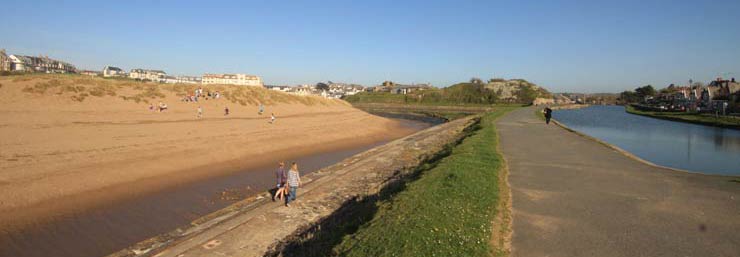 |
|||||||||
The Bude Canal was built primarily to transport sea sand, rich in lime, to farms in North Cornwall & West Devon, where the soil was poor. Sea-going vessels using the sea lock with a depth of 15 feet on an average spring tide brought coastal cargoes of limestone coal and general merchandise. The lock is one of the last working sea locks in the country and well worth a visit. The Bude Canal is an 18th-century canal that runs for approximately 35.4 kilometers (22 miles) from the town of Bude on the North Cornwall coast in England to the village of Launceston in East Cornwall. It was built to transport lime-rich sand and sea-sand from the coast to the fields in the interior of the county to improve agricultural productivity. The canal was also used for transporting other goods, such as coal, lime, and slate, and later for shipping agricultural produce to the coast. The Bude Canal was constructed between 1794 and 1825 under the supervision of the engineer James Whiteside. The initial plan was to extend it further inland, but this was abandoned due to the high cost and the advent of railway transportation. The canal starts from the Bude Sea Lock in the town of Bude, which is now a popular tourist attraction. It follows the contours of the local landscape, passing through a series of locks, aqueducts, and tunnels, before reaching the Tamar Estuary near Launceston. The route includes an impressive 2.5-mile (4 km) long Tamar Canal, which connects the Bude Canal to the Tamar River. Notable features along the canal include the 305-meter (1,000-foot) long Tamar Tunnel, which is one of the oldest and longest navigable tunnels in the UK, and the 18-meter (60-foot) high Poughill Viaduct, which was the highest in Cornwall at the time of its construction. The Bude Canal saw a decline in use with the rise of the railway network in the 19th century. It was abandoned for commercial traffic in 1901. However, efforts have been made to restore and preserve the canal, and it is now used mainly for leisure purposes such as canoeing, kayaking, and walking.The canal was operated by the Bude Canal Company until it was taken over by the local council in the early 20th century. The company was dissolved in 1905. The Bude Canal was designated a Conservation Area in 1975, and several restoration projects have been undertaken since then. The Bude Canal and Harbour Society is a group of volunteers dedicated to preserving and enhancing the canal's heritage. The canal is a haven for wildlife, with various species of birds, fish, and plants thriving along its banks. It is also part of the Cornwall Area of Outstanding Natural Beauty (AONB). Today, the Bude Canal is a popular destination for leisure and recreational activities. It offers a serene environment for walking, cycling, fishing, and boating. The towpath is used by walkers and cyclists as part of the Sustran's National Cycle Network Route 3. The canal once connected to the Atlantic coastline at Bude, but the section from the sea lock to the harbor was infilled in the mid-20th century. It is now a tranquil inland waterway surrounded by countryside. The Bude Canal is an important part of Cornwall's industrial heritage and is recognized for its historical significance. It provides insights into the transportation methods and economic developments of the region during the late 18th and early 19th centuries.The canal is a picturesque and peaceful place to visit, offering a glimpse into the past and an enjoyable way to explore the scenic Cornish countryside. The restoration work has not only preserved a piece of history but also created a valuable asset for local communities and tourists. HELEBRIDGE - The first part of the Bude Canal, from the sea locks to Helebridge, is a traditional barge lock canal, and is still navigable, although the lock gates at Rodds Bridge and Whalesborough have long since been replaced with concrete spillways. A level canalside walk, either to Helebridge and back, or travelling via Upton or Widemouth Bay, back to Bude, takes in not only the canal, but also the nature reserve, and a wide variety of differing wildlife habitat. At Helebridge itself, after crossing the A39, one can see the old wharf area, and the restored barge workshop, where the local council have set up a pleasant picnic area. The
Battle of Stratton
|
|||||||||
|
|||||||||
|
|
|||||||||

Self-catering Holiday Rental in Bude sleeps 4. Pets Welcome

Tel: 07814488152. Self-catering Holiday Rental in Marhamchurch, near Bude with Sea Views- sleeps 6. - suitable for Large Groups, Fri Changeover, Prices from £550 to £2290

Tel: 07899950154. Self-catering Holiday Cottage Rental in St Gennys nr. Crackington Haven with Sea Views- sleeps 6. Sat Changeover, Prices from £390 to £990 Pets Welcome

Tel: 01959 569096. Self-catering Holiday Rental in Bude with Sea Views- sleeps Over 10 people Pets Welcome

En-Suite B&B Stays in Bude sleeps Over 10 people
